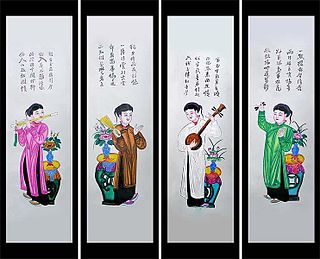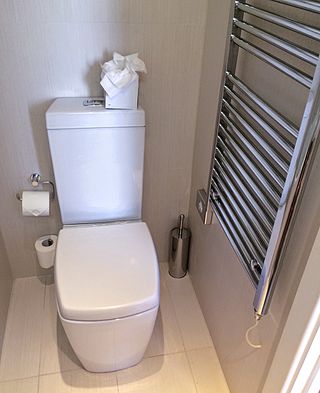
Geordie is an English dialect spoken in the Tyneside area of North East England, especially connected with Newcastle upon Tyne, and sometimes known in linguistics as Tyneside English or Newcastle English. The Geordie dialect and identity are primarily associated with a working-class background. A 2008 newspaper survey found the Geordie accent to be perceived as the "most attractive in England" among the British public.
Panoramic paintings are massive artworks that reveal a wide, all-encompassing view of a particular subject, often a landscape, military battle, or historical event. They became especially popular in the 19th century in Europe and the United States, inciting opposition from some writers of Romantic poetry. A few have survived into the 21st century and are on public display. Typically shown in rotundas for viewing, panoramas were meant to be so lifelike they confused the spectator between what was real and what was image.

Banner-making is the ancient art or craft of sewing banners. Techniques used include applique, embroidery, fabric painting, patchwork and others.

Chinese painting is one of the oldest continuous artistic traditions in the world. Painting in the traditional style is known today in Chinese as guó huà, meaning "national painting" or "native painting", as opposed to Western styles of art which became popular in China in the 20th century. It is also called danqing. Traditional painting involves essentially the same techniques as calligraphy and is done with a brush dipped in black ink or coloured pigments; oils are not used. As with calligraphy, the most popular materials on which paintings are made are paper and silk. The finished work can be mounted on scrolls, such as hanging scrolls or handscrolls. Traditional painting can also be done on album sheets, walls, lacquerware, folding screens, and other media.

Winslow Homer was an American landscape painter and illustrator, best known for his marine subjects. He is considered one of the foremost painters of 19th-century America and a preeminent figure in American art in general.

South Shields is a coastal town in South Tyneside, Tyne and Wear, England; it is on the south bank of the mouth of the River Tyne. The town was once known in Roman times as Arbeia and as Caer Urfa by the Early Middle Ages. In 2021 it had a population of 75,337. It is the fourth largest settlement in Tyne and Wear, after Newcastle upon Tyne, Sunderland and Gateshead.

Annfield Plain is a village in County Durham, in England. It is situated on a plateau between the towns of Stanley, 3 mi (4.8 km) to the north-east, and Consett, 5 mi (8.0 km) to the west. According to the 2001 census, Annfield Plain had a population of 3,569. By the time of the 2011 Census Annfield Plain had become a ward of Stanley parish. The ward had a population of 7,774. Along with much of the surrounding area, Annfield Plain's history was coal mining.

Beamish Museum is the first regional open-air museum, in England, located at Beamish, near the town of Stanley, in County Durham, England. Beamish pioneered the concept of a living museum. By displaying duplicates or replaceable items, it was also an early example of the now commonplace practice of museums allowing visitors to touch objects.

Korean painting (Korean: 한국화) includes paintings made in Korea or by overseas Koreans on all surfaces. The earliest surviving Korean paintings are murals in the Goguryeo tombs, of which considerable numbers survive, the oldest from some 2,000 years ago, with varied scenes including dancers, hunting and spirits. It has been hypothesized the Takamatsuzuka Tomb in Japan, from the 7th-century end of the Goguryeo period, has paintings with Goguryeo influence, either done by Goguryeo artists, or Japanese one trained by Goguryeo people. Since a lot of influences came into the Korean peninsula from China during the Three Kingdoms period. Until the Joseon dynasty the primary influences came from Chinese painting though done with Korean landscapes, facial features, Buddhist topics, and an emphasis on celestial observation in keeping with the rapid development of Korean astronomy.

Chichester is a station on the Tyne and Wear Metro serving the Chichester, Laygate, Westoe and West Park areas of South Tyneside, as well as the nearby South Tyneside College campus. The station is affectionately referred to as 'Chi' by locals.

Robert Seldon Duncanson was a 19th-century American landscapist of European and African ancestry. Inspired by famous American landscape artists like Thomas Cole, Duncanson created renowned landscape paintings and is considered a second generation Hudson River School artist. Duncanson spent the majority of his career in Cincinnati, Ohio and helped develop the Ohio River Valley landscape tradition. As a free black man in antebellum America, Duncanson engaged the abolitionist community in America and England to support and promote his work. Duncanson is considered the first African-American artist to be internationally known. He operated in the cultural circles of Cincinnati, Detroit, Montreal, and London. The primary art historical debate centered on Duncanson concerns the role that contemporary racial issues played in his work. Some art historians, like Joseph D. Ketner, believe that Duncanson used racial metaphors in his artwork, while others, like Margaret Rose Vendryes, discourage viewers from approaching his art with a racialized perspective.

Vietnamese art is visual art that, whether ancient or modern, originated in or is practiced in Vietnam or by Vietnamese artists.

American realism was a movement in art, music and literature that depicted contemporary social realities and the lives and everyday activities of ordinary people. The movement began in literature in the mid-19th century, and became an important tendency in visual art in the early 20th century. Whether a cultural portrayal or a scenic view of downtown New York City, American realist works attempted to define what was real.

Westoe was originally a village near South Shields, in the South Tyneside district, in Tyne and Wear, England, but has since become part of the town and is now used to refer to the area of the town where the village once was. It is also an electoral ward for local political purposes.

Steam Elephant was an early steam locomotive from North East England.

A toilet is a piece of sanitary hardware that collects human waste, and sometimes toilet paper, usually for disposal. Flush toilets use water, while dry or non-flush toilets do not. They can be designed for a sitting position popular in Europe and North America with a toilet seat, with additional considerations for those with disabilities, or for a squatting posture more popular in Asia, known as a squat toilet. In urban areas, flush toilets are usually connected to a sewer system; in isolated areas, to a septic tank. The waste is known as blackwater and the combined effluent, including other sources, is sewage. Dry toilets are connected to a pit, removable container, composting chamber, or other storage and treatment device, including urine diversion with a urine-diverting toilet.

Robert "Bob" Olley is an artist and sculptor best known for his mining subjects, humorous drawings and paintings of everyday life, especially his iconic painting and internationally acclaimed Westoe Netty.

A pissoir is a French invention, common in Europe, that provides a urinal in public space with a lightweight structure. The availability of pissoirs aims to reduce urination onto buildings, sidewalks, or streets. They can be freestanding and without screening, with partial screening, or fully enclosed.

Realism was an artistic movement that emerged in France in the 1840s, around the 1848 Revolution. Realists rejected Romanticism, which had dominated French literature and art since the early 19th century. Realism revolted against the exotic subject matter and the exaggerated emotionalism and drama of the Romantic movement. Instead, it sought to portray real and typical contemporary people and situations with truth and accuracy. It did not avoid unpleasant or sordid aspects of life. The movement aimed to focus on unidealized subjects and events that were previously rejected in art work. Realist works depicted people of all social classes in situations that arise in ordinary life, and often reflected the changes brought by the Industrial and Commercial Revolutions. Realism was primarily concerned with how things appeared to the eye, rather than containing ideal representations of the world. The popularity of such "realistic" works grew with the introduction of photography—a new visual source that created a desire for people to produce representations which look objectively real.


















